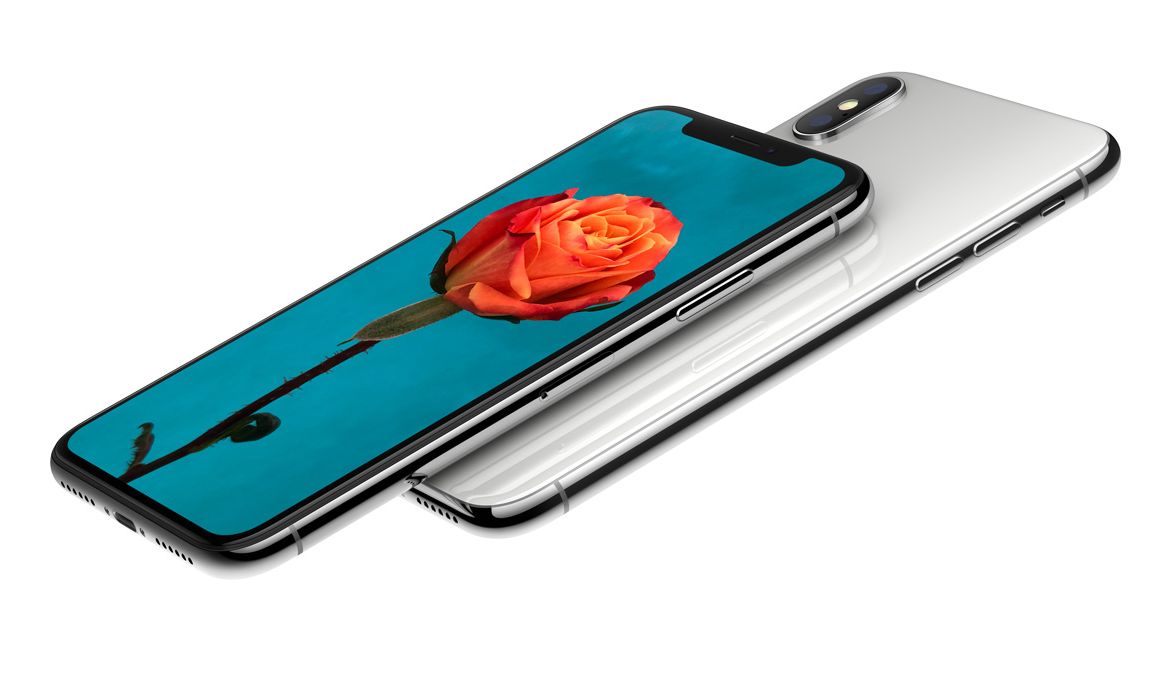Thomas Welch, Reporter
@twelchcourant
The iPhone X is one of the biggest steps in Apple’s entire production history, but with that came a lot of controversy. The infamous notch, no home button, the OLED display, and a new processor make up the things that have been put up for debate as to whether this phone would be a huge win or a total flop. There are plenty of things that make this phone what it is, so let’s get into it.
The camera is one of the most defining features on the phone. Apple is known for its high quality and

very adaptive pictures. First, we see that there are two cameras similar to the ones on the 7plus and 8plus, except it’s upright. They have a strong, sapphire crystal lens cover to protect it and get clear photos. This top camera is a standard telephoto, while the lower one is wide-angle, which allows you to use optical zoom instead of digital, giving you clearer and closer images than ever before. One feature which Apple has nailed on the head is portrait mode. It uses body and face detection to get a great focus on the subject while blurring the background. The lighting is still in beta, but the images themselves are amazing. This is personally one of my favorite parts of the phone. Now, if you like taking video on your phone too, then there is yet another feature for you. The phone is capable of video up to 4K at 60fps, which is amazing. It also has camera stabilization, so minor hand movements and minimal swaying will be compensated for, making your video as straight and clear as possible. The slow motion and time lapse options also look great with the 12 megapixel camera and fast speed video.
One of the biggest concerns with the new phone was the all glass back. It’s claimed to be the “strongest glass available” according to Apple, and is the same glass on the front. This glass back is seen as another step towards the future of devices, because it allows for wireless charging. If we move to the side, we see the stainless steel edge between the glass front and back. It actually holds up very well to drops and scratches. The whole thing is splash water and dust resistant, so you should be covered there. Because of the lack of a home button there are multiple gestures needed to be relocated around the phone, so they made the power button into a much more versatile feature. You press once to turn on and off as usual, but you can also press twice for Apple Pay and if you hold it down you activate Siri.

At the bottom, unfortunately the headphone jack is still absent, but we do see the standard lightning port (now supports fast charging) and what appears to be a stereo speaker. Many have gone to Apple forums and asked why the left “speaker” isn’t working and it’s because it’s a barometric vent that, for whatever reason, they made identical to the speaker. The second, another stereo speaker, is where you get audio for phone calls at the top of the phone. I really like this feature because you now you get audio from both ends of the phone which is great when you’re watching videos or playing games. However, with these videos and games, there is a small problem. When you go to watch a video, you’ll see these black bars on the sides and with Youtube and other video sites there are options to resize it, but it cuts off those top and bottom areas and part of the side is covered by the notch as well. It’s kind of disappointing, but with the screen ratio it’s as good as it gets.
The display on this phone is truly unlike any other iPhone before it. The display is 5.8 inches, which is bigger than plus-size iPhones despite being much closer to a standard 7 or 8 size. It’s far more advanced than the usual LED displays the previous models use. It has a super retina HD OLED display, which is made by Samsung. The usual contrast ratio for the other displays, the 8 plus for example, is 1300:1 or less. But the iPhone X is 1,000,000:1. It has a 2436 -1125 pixel resolution with 458 pixels per inch. That plus the mechanics within the display make for brighter and sharper colors, paired with darker blacks. It also consumes less battery than a standard LED and has a fingerprint-resistant coating.
Now lets take a look at some more aspects of the front of the phone. The removal of the home button for a full-frontal screen was a dangerous, but necessary move for Apple. Some people don’t like it, but I think it looks good and I got completely used to it within a day or two of having the phone. The typical functions of the home button have all been relocated to other parts of the screen, which I’ll get to later.

One thing that had to be changed because of the home button removal was Touch ID, but what they replaced it with is awesome. With other companies using similar features, like facial recognition and eye recognition, Apple has vastly outdone them with Face ID. It uses their True Depth system, which requires a number of components within the phone. There’s a proximity and ambient light sensor, which determines if you are attempting to use Face ID and then how much light to use to properly scan your face. Then, it uses a flood illuminator to light up your face with infrared light, which it can utilize to scan while you can’t see it. This allows you to use the feature without even turning a light on. One of the most important parts is the dot projector which shoots out 30,000 dots, then maps out where they land. Using those 30,000, they cross-reference it against your original scan. If they match, it unlocks. The dot projection means that it can’t be fooled with a 2-dimensional picture. All of these happen in complete succession, in a split second. It’s one of the greatest things on the phone in my opinion.
The internals of the phone are also quite impressive. Apple has ditched its relatively new A10 fusion chip, a breakthrough of its own, for its A11 bionic chip. It’s used in the X and the 8, and has 6 cores, which range anywhere from 25% to 75% faster than the A10. The battery is also a stand-out part of the phone. It supports fast-charging, which can give you up to 50% charge in 30 minutes. It’s bigger and better than the previous batteries, getting you 2 hours more life than with the iPhone 7. A big part of that is due to the OLED display and the A11 chip, which are faster and better while consuming less battery.
There are a few interesting internal functions that reflect the lack of a home button. Since you can’t press the button to wake your phone, raise to wake and tap to wake are good options. Personally, I like tap to wake a lot better, because your phone won’t open every time you move it up and down. It also has moved the control center to the top right to allow the swipe up function to go home. It does take some time to get used to, but Apple does it very well. The only critique I have for this is when the phone is horizontal it’s very hard to get the control center open.
The iPhone X comes standard with iOS 11, which is great. The customizable control center is awesome, and now has features like screen recording and a magnifier. iMessages has also been updated. It, like the other Apple apps, has a new look, similar to Apple Music before the update. The iMessage apps, which were a good feature before, have been organized into an easy and convenient menu. Siri has been updated and can now translate a number of languages, as well as recommend songs for you based off of your Apple Music listening habits. The App Store was redesigned and has been made much easier to navigate. But, my favorite feature of iOS 11 is the new screenshot menu. When you take a screenshot, it appears as a small icon in the corner of the screen. You can then mark it up, send it, or delete it all without exiting your current app. It’s awesome, especially when you use it often, and it’s an example of what Apple can do to streamline every aspect of the phone.

There’s so much potential for this phone. Portrait mode is an amazing feature that can step up your photo game. Face ID is super secure and works fast and consistently. iOS 11 is great and has improved on a ton of things for the phone. However, because the phone is still new, there are some things holding it back. In the control center, you can’t turn bluetooth off all the way. That makes it very frustrating to actually control. The new screen proportions and the notch also pose a number of problems. Many apps just leave black bars at the top and bottom, and some cut out certain spots to fill the screen. However, more and more developers are optimizing so it will continue to improve. But videos can’t have the whole image covering the entire screen without being stretched, such as in YouTube.
I would highly recommend the iPhone X, under the correct circumstances. If you have an iPhone 6s or later, you’re probably fine and don’t need a new phone right now. But if your plan allows you an upgrade, or if you have an earlier phone, or simply one that doesn’t work, this may be for you. It has plenty of great features, that some would potentially use more than others. If you don’t need a 1,000,000:1 contrast ratio or Face ID, or generally don’t need a $1,000+ phone, an iPhone 8 might be a better option. But if you want a 12-megapixel camera and the revolutionary innovation of a full-frontal screen by Apple, then the iPhone X is for you. If you have a little more time until you’ll need a new phone, wait for a bit. Apple is coming out with 3 new phones next year, which will be exceptional themselves.




